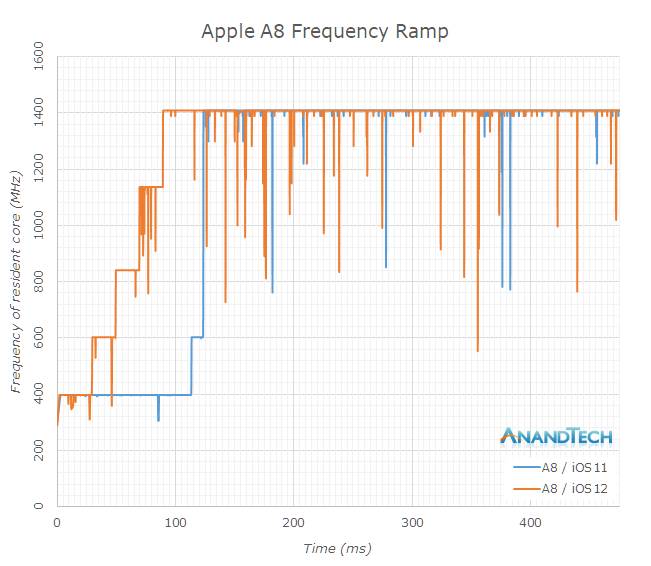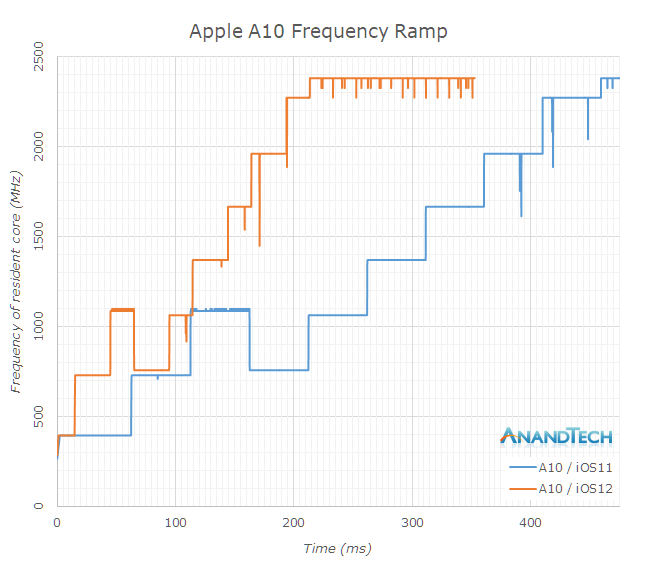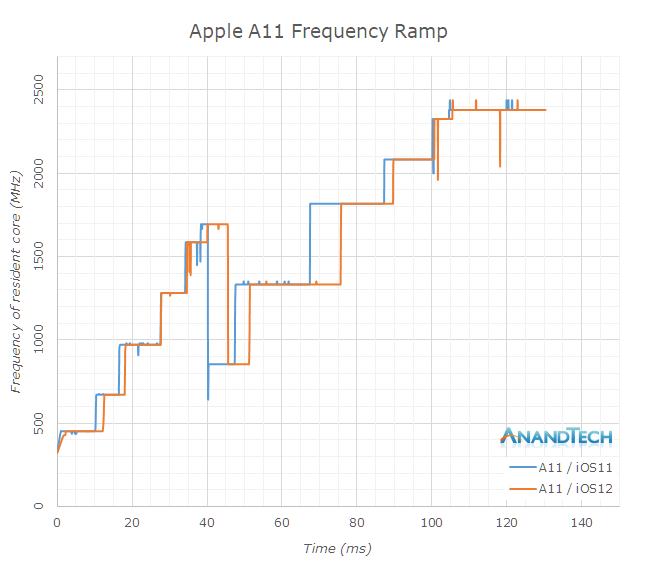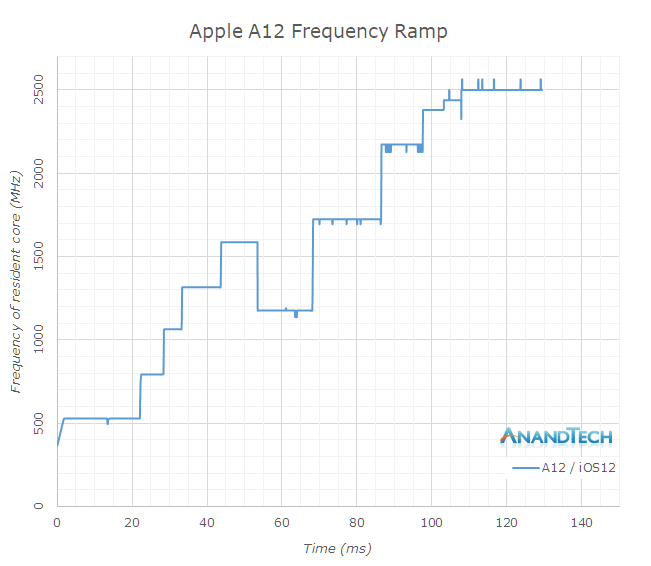The iPhone XS & XS Max Review: Unveiling the Silicon Secrets
by Andrei Frumusanu on October 5, 2018 8:00 AM EST- Posted in
- Mobile
- Apple
- Smartphones
- iPhone XS
- iPhone XS Max
System Performance
While synthetic test performance is one thing, and hopefully we’ve covered that well with SPEC, interactive performance in real use-cases behaves differently, and here software can play a major role in terms of the perceived performance.
I will openly admit that our iOS system performance suite looks extremely meager: we are only really left with our web browser tests, as iOS is quite lacking in meaningful alternatives such as to PCMark on the Android side.

Speedometer 2.0 is the most up-to-date industry standard JavaScript benchmark which tests the most common and modern JS framework performance.
The A12 sports a massive jump of 31% over the A11, again pointing out that Apple’s advertised performance figures are quite underselling the new chipset.
We’re also seeing a small boost from iOS 12 on the previous generation devices. Here the boost comes not only thanks to an a change in how iOS’s scheduler handles load, but also thanks to further improvements in the ever evolving JS engine that Apple uses.

WebXPRT 3 is also a browser test, however its workloads are more wide-spread and varied, containing also a lot of processing tests. Here the iPhone XS showcases a smaller 11% advantage over the iPhone X.
Former devices here also see a healthy boost in performance, with the iPhone X ticking up from 134 to 147 points, or 10%. The iPhone 7’s A10 sees a larger boost of 33%, something we’ll get into more detail in a little bit.
iOS12 Scheduler Load Ramp Analyzed
Apple promised a significant performance improvement in iOS12, thanks to the way their new scheduler is accounting for the loads from individual tasks. The operating system’s kernel scheduler tracks execution time of threads, and aggregates this into an utilisation metric which is then used by for example the DVFS mechanism. The algorithm which decides on how this load is accounted over time is generally simple a software decision – and it can be tweaked and engineered to whatever a vendor sees fit.
Because iOS’s kernel is closed source, we’re can’t really see what the changes are, however we can measure their effects. A relatively simple way to do this is to track frequency over time in a workload from idle, to full performance. I did this on a set of iPhones ranging from the 6 to the X (and XS), before and after the iOS12 system update.
Starting off with the iPhone 6 with the A8 chipset, I had some odd results on iOS11 as the scaling behaviour from idle to full performance was quite unusual. I repeated this a few times yet it still came up with the same results. The A8’s CPU’s idled at 400MHz, and remained here for 110ms until it jumped to 600MHz and then again 10ms later went on to the full 1400MHz of the cores.
iOS12 showcased a more step-wise behaviour, scaling up earlier and also reaching full performance after 90ms.
The iPhone 6S had a significantly different scaling behaviour on iOS11, and the A9 chip’s DVFS was insanely slow. Here it took a total of 435ms for the CPU to reach its maximum frequency. With the iOS12 update, this time has been massively slashed down to 80ms, giving a great boost to performance in shorter interactive workloads.
I was quite astonished to see just how slow the scheduler was before – this is currently the very same issue that is handicapping Samsung’s Exynos chipsets and maybe other Android SoCs who don’t optimise their schedulers. While the hardware performance might be there, it just doesn’t manifest itself in short interactive workloads because the scheduler load tracking algorithm is just too slow.
The A10 had similar bad characteristics as the A9, with time to full performance well exceeding 400ms. In iOS12, the iPhone 7 slashes this roughly in half, to around 210ms. It’s odd to see the A10 being more conservative in this regard compared to the A9 – but this might have something to do with the little cores.
In this graph, it’s also notable to see the frequency of the small cores Zephyr cores – they start at 400MHz and peak at 1100MHz. The frequency in the graph goes down back to 758MHz because at this point there was a core switch over to the big cores, which continue their frequency ramp up until maximum performance.
On the Apple A11 – I didn’t see any major changes, and indeed any differences could just be random noise between measuring on the different firmwares. Both in iOS11 and iOS12, the A11 scales to full frequency in about 105ms. Please note the x-axis in this graph is a lot shorter than previous graphs.
Finally on the iPhone XS’s A12 chipset, we can’t measure any pre- and post- update as the phone comes with iOS12 out of the box. Here again we see that it reaches full performance after 108ms, and we see the transition of the tread from the Tempest cores over to the Vortex cores.
Overall, I hope this is the best and clear visual representation of the performance differences that iOS12 brings to older devices.
In terms of the iPhone XS – I haven’t had any issues at all with performance of the phone and it was fast. I have to admit I’m still a daily Android user, and I use my phones with animations completely turned off as I find they get in the way of the speed of a device. There’s no way to completely turn animation off in iOS, and while this is just my subjective personal opinion, I found they are quite hampering the true performance of the phone. In workloads that are not interactive, the iPhone XS just blazed through them without any issue or concern.















253 Comments
View All Comments
Glindon-P - Friday, October 5, 2018 - link
Wider color range only works at 30fps because the camera actually records 2 frames at different exposures (at 60fps) and combines them.As far as higher FPS slow mo I’m sure it boils down to taking in enough light at high frame rates to be usable enough or just not something enough users care about. Anecdotally I’ve only used it just to test it and never again.
varase - Tuesday, October 23, 2018 - link
480 or 960fps slow mo is basically a gimmicky misnomer - how long can they sustain that frame rate before all the buffers fill up?How many takes does it require to actually capture the action you're trying to film within the window that that high frame rate actually operates?
Star_Hunter - Friday, October 5, 2018 - link
In past iPhone reviews NAND performance was looked at, I assume since it wasn't included this year that it remains the same?Andrei Frumusanu - Friday, October 5, 2018 - link
NAND is something on the to-do list in terms of revamping the test methodology - currently it's a mess both on iOS and Android.whiskeysips - Friday, October 5, 2018 - link
Can Anandtech take an photo of how the iPhone XS reproduces the following image on their review model?https://i.postimg.cc/q7wty6zY/Image-1.jpg
I have (5) iPhone XS has very poor color production on the following image, especially compared to my older iPhone7, see the example below:
https://i.postimg.cc/fbgFNbb1/226_E617_D-_A701-43_...
All of my iPhones also have a white point that appears significantly lower than 6500k judging by my eye. I do not have a colorimeter, but they do seem significantly off with certain content.
Unless the review models are cherry picked, I do not see retail units reaching the same quality.
Andrei Frumusanu - Friday, October 5, 2018 - link
How exactly are you expecting to test colour accuracy of an image through a photo?As far as I'm aware, the phones aren't cherry-picked and they were sealed and the battery was uninitialised.
whiskeysips - Friday, October 5, 2018 - link
The reference image is a screen shot of the content to be displayed so source content should be preserved.The color differences in the camera photo do reflect what I see with my eyes to a significant degree.
That is, on my iPhone7 and all my monitors in the house, the screenshot appears deep red at the top with a greyish red on the listed content.
On all the iPhone XS's in household, the content appears light red at the top, with the listed content becoming a distinct shade of brown instead of a greyish red.
I appreciate reading my post. The displays on my models do not seem all that accurate to me.
PhilJohn - Friday, October 5, 2018 - link
Have you properly calibrated the other phones and monitors in your house with a colorimeter? You'd be surprised at the awful D.e on most monitors out of the box.When the displays were tested for colour accuracy they were marked very highly, so it could very well be that the XS is showing the CORRECT colours.
whiskeysips - Friday, October 5, 2018 - link
So you are saying that all my previous iPhones I have retired, my current macbook, my spouses iMac, all the TV's in the household, and my two (non-Apple) desktop are all incorrect?AMC's brand color is red. The XS screen shows something similar to dried blood or a brown-red.
Did the app designers also have incorrectly calibrated monitors? The XS calibration is the problem, not the other way around.
PhilJohn - Friday, October 5, 2018 - link
And you've got night shift and true tone off? It could just be you have a dodgy OLED panel, check it against the ones in a store and exchange it if so.But you'd be surprised how awful most consumer electronics are for colour calibration, people like "pop" and "vivid" even when it's totally oversaturated and nowhere near accurate.
The calibration charts in this article should point to the XS having exceedingly accurate colours.